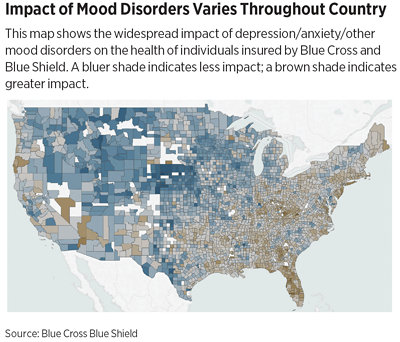Insurer Data Show Mental Illness, Substance Use Among Top Five Conditions
Abstract
The data on the impact of mental illness and substance use disorders demonstrate the importance of ensuring compliance with the federal parity law and the need for the recently passed 21st Century Cures Act.
Mood disorders and substance use disorders were among the top five conditions affecting the health of individuals insured by Blue Cross and Blue Shield (BCBS) in 2015.
The findings are based on data from more than 40 million commercially insured members. At the top of the list affecting longevity and quality of life was “depression/anxiety/and other mood disorders.” Substance use disorders were number five. The other conditions were hypertension, diabetes, and high cholesterol.
“This new report highlights the impact of mental health and substance use disorders on people’s health and quality of life and reinforces the importance of making access to quality mental care for all a national priority,” said APA President Maria A. Oquendo, M.D., Ph.D. “In addition, we can implement effective prevention and early intervention efforts that can significantly reduce the potential impact of mental health conditions and improve lives.”
APA CEO and Medical Director Saul Levin, M.D., M.P.A., said the data also show the need for parity when it comes to coverage of mental illness.
“Providing effective treatment for mental health and substance use disorders will benefit not only individuals and their families, but also their employers through reduced absenteeism, disability, and turnover costs,” Levin said. “Despite much progress, many people with mental health conditions are not getting the care they need.”
Levin added that the bipartisan 21st Century Cures Act, passed by Congress and signed by President Obama last month, will go a long way in addressing the barriers and challenges and improving access to quality mental health care for all.
The BCBS data are derived from the company’s Health Index. Using blinded claims data from more than 40 million commercially insured members of BCBS companies, the Health Index measures the impact of more than 200 common diseases and conditions on overall health and wellness by assigning each county in the United States a health metric between 0 and 1, designating the proportion of optimal health reached by the county’s population. For example, a measurement of .9 indicates that, on average, the population of a county is living at 90 percent of its optimal health. In other words, the county population could gain up to 10 percent in healthy lifespan by addressing the top health conditions impacting their area.

The index is interactive, allowing users to focus on specific states and counties or on specific conditions. For instance, selecting “depression/anxiety/mood disorders” shows the pervasive impact of those conditions on the health of insured individuals throughout the United States (see chart).
“Blue Cross and Blue Shield companies are committed to transforming our health care system and the health of our nation through actionable data,” Scott Serota, president and CEO for the Blue Cross Blue Shield Association, said in a statement. “This index uses the breadth and depth of BCBS data to bring critical health insights to policymakers, community leaders, business leaders, and health care professionals, helping them further focus efforts to improve their communities’ health.”
The BCBS Health Index is also paired with an economic analysis by Moody’s Analytics showing how conditions impact the economic well-being of communities. The analysis shows a direct link between healthy people and a healthy economy with healthier counties having lower unemployment and higher incomes.
The Health Index is informed by consultation with the Institute for Health Metrics and Evaluation, an independent global health research center at the University of Washington in Seattle. The center helped BCBS define condition categories and measure their disabling affects. ■



